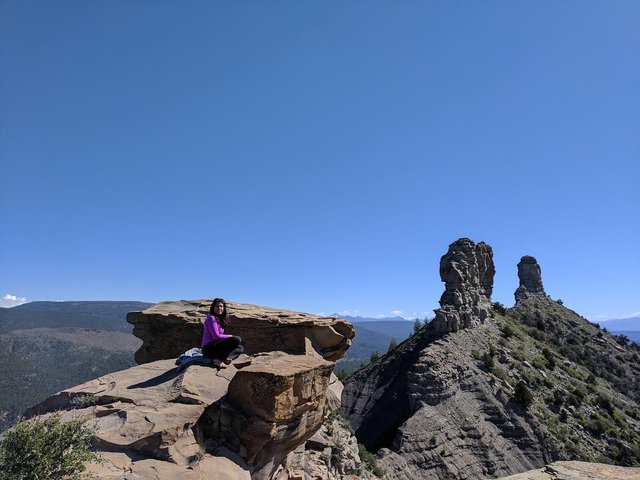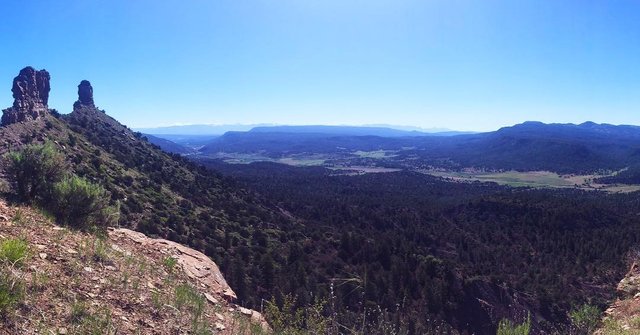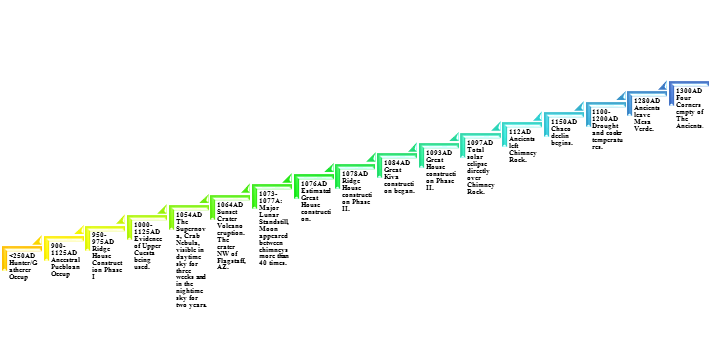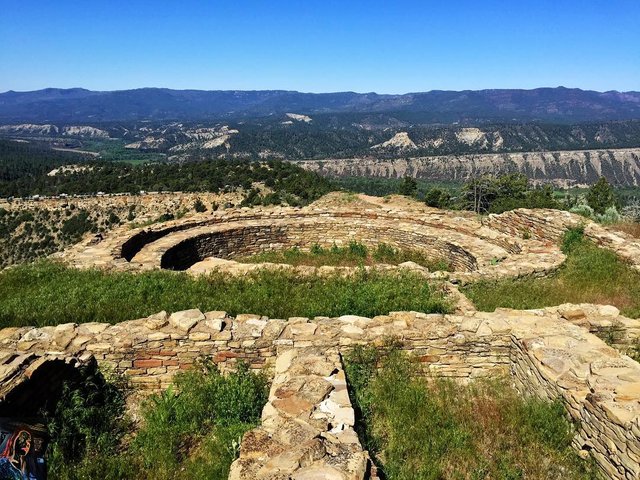Chimney Rock National Monument

At the edge of the southern San Juan mountains, in the State of Colorado you will find one of the most interesting historical landmarks in the United States. If you walk into the ancestral lands of The Ancients, you can still hear the drums beating and voices singing. In modern times, ceremonies are still held in this area and are considered sacred. The name of this particular region is called Chaco Canyon and I will be sharing some information about a site called Chimney Rock that is located within Chaco Canyon.

Chimney Rock is approximately seven miles and is a preservation for 200 ancient dwellings, ceremonial buildings, a Great Kiva, Pit House, a Great House Pueblo, and a multi-family dwelling. Chimney Rock is the highest in elevation at 7,000 feet and the hike to the top is approximately a half a mile. Once you reach the top, you will be able to see all the way to New Mexico and appreciate the local view of Colorado. According to my people, The Ancients the verbal history is that man developed in this area, at least a portion of them. I am from the Hopi tribe and this is the area we call the navel and the Great Kiva represents the opening.

Chimney Rock
Chimney Rock is constructed of majestic natural stone pillars and has a major standstill of the moon. It is said through oral history that the structure itself was once a huge astronomical dwelling, but over time the structure has fallen and what is still standing is an amazing formation.
What can be still seen from the Great House Pueblo are towers slightly out of line but frames the sky. The most important time dating back to The Ancients is the Winter Solstice. The full moon rises between the two pillars and is only visible at limited locations on top of the Mesa. The Great House was built by the early Chacoan settlers. There are debates as to the origination date, but was clearly visible by 1076 AD. If you ask my ancestors they will just say, it has always been there. Sometimes the most important aspect of history is remembering the stories and traditions. Shrugs.
Most wood samples date back from 1093 to 1094 AD and archeologist like to agree that The Ancients constructed dwellings to read and live their lives by the skies. I like the ring of that, so I will keep that as a positive analysis, this also makes sense since most ancient cultures lived by the reading the season, oceans, agriculture by the same formula.
Some archaeologists claim that the people of Chimney Rock celebrated astronomical events. This is well documented in the Great House construction by the visibility of the rare lunar events protected by Chimney Rock’s twin monoliths. In 2009, newfound wood samples date to the northern lunar standstills of 1018 AD and minor lunar standstills of 1011 AD. The alignment of the Great House Pueblo and Chimney Rock pillars with the moon has been calculated, surveyed, confirmed and photographed. There is no questions that this is a sacred site and the location was used for journeying, spiritual awareness, and more.
- Skywatchers - those whose knowledge of being able to predict, almost to the day, when certain astronomical events were likely to occur attained prestige and control which gave them political power and social ranking. This position is believed to have been given to the High Priest.
The purpose of the Chimney Rock Great House was to house the high priest whose skill was the study of the sun and the stars. The connection between the lunar standstill and the natural pinnacles, Chimney Rock and Companion Rock, gave the site a special sacredness. The site is sacred and the high priests were, in effect, agents of the gods.

History Explained
Chimney Rock’s eight villages are known as North Piedra, South Piedra, Ravine, Pyramid Mountain, Stollsteimer Mesa, the High Mesa, the East Slope, and Peterson Gulch.
The biologically rich mountain zone and habitat of Chimney Rock National Monument yielded a variety of wild foods and game to supplement The Ancient’s who cultivated crops of corn, beans, and squash. Flora and fauna were used for food and tools. Many of these native species are still evident at Chimney Rock today. Even the rocks provided shelter. The hard sandstone was an ideal building material that has stood the test of time. The stone pinnacles may have been the reason for building on this high mesa which stood at the northeastern edge of civilization a thousand years ago.
Graphical Timeline

Period Timeline
| Cultural Tradition | Time Period | Archaeological Phase |
|---|---|---|
| Basketmaker II | 0–400AD | Pine |
| Basketmaker III | 400–700AD | Sambrito |
| Early Pueblo I | 700–850AD | Rosa |
| Late Pueblo II | 850–950AD | Piedra |
| Early Pueblo I | 950–1050AD | Arboles |
| Late Pueblo II | 1050–1150AD | Chimney Rock |
| Pueblo III | 1150–1350AD | |
| Pueblo IV | 1350–1600 AD |
North American Development - According to archaeologists the earliest humans recorded were hunter gatherers during the Paleo-Indian from 12,000 BC to 7,000 BC. The Paleo-Indians hunted small game, camel, sloth, horse, lion, and mammoth. Technologies across North America and into South America during this period is of highly mobile hunters who had social connections across a large area.
Archaic Period - The Paleo-Indian period transitions into the Archaic period in 7,000 BC. There was a decline in big game hunting and a focus on edible plants. Traces of distinct artifacts have been found along with a more social connection to specific locations. In the American Southwest, grinding technologies such as the mano and metate surfaced, and snares were used. During the Archaic Period, we see evidence of maize and it is clear people knew how to cultivate plants from seeds. Throughout the Late Archaic/Early Agricultural/Early Pithouse period, the American Southwest was shaped by interaction with Mesoamerica.
Village Period - The period between 1500 BC and 500 AD, the Southwest is known as the Late Archaic/Early Agricultural/Early Pithouse period. During this time, people moved toward living in a village and growing agriculture. Researchers have come to believe Uto-Aztecan migrations accompanied the maize. By 2000 BC, corn seed appears across the Southwest. By 1000 BC, maize was being cultivated in some areas. Small pit house villages began to appear between 1700 BC and 1500 BC.
Agriculture - Around 500 AD, an Uto-Aztecan migration out of the deserts entered the the Chimney Rock. This interpretation is supported by the dramatic change in the artifacts, language, and DNA evidence. Near Chimney Rock, agriculture appears to have been extensivley adopted in reaction to the Uto-Aztecan immigration.
During the Basketmaker III period 500 AD to 750 AD, an architectural and artifact style can be recognized in the Northern San Juan region. Pit structures are the typical style and is made with stone and ceramic. This is the first time in history that the population exceeds 1,000 people.
The Pueblo I period 750 AD to 900 AD, large villages appear and clusters of Pueblo I sites near Durango, in the Piedra District, and in the Navajo Reservoir. Ceramic vessels became increasingly diverse.
The majority of Pueblo II sites are located closely to the Chimney Rock pinnacles. Pueblo II sites are characterized by Great Kivas, an indication of ritual gatherings. Most communities continue to consist of dispersed homesteads and hamlets, and e develop a nucleus. Agriculture became an even greater component of the Pueblo II strategy than in previous periods. Long distance trade increased within the Chaco regional system.
Since Basketmaker III - Sambrito Phase times 400 AD to 700 AD, a region wide social settlement pattern is seen throughout the Four Corners. An extensive distribution of similar pottery regarding all things social, economic, and ceremonial.
After the end of Late Pueblo II 1125 AD, the Four Corners environment changed to less rainfall, smaller crops, the failure of priests to predict these changes and, during the Pueblo III period around 1200 AD, the Four Corners are is immersed in warfare.

Spiritual and Astronomical Center
In addition to material goods, Chimney Rock communicated calendrical knowledge to Chaco for setting the dates of economic festivals, religious ceremonies, and rituals. Because of the cultural significance of the Northern Major Lunar Standstill Event, Chimney Rock was a host of Chaco ceremonies and pilgrimage festivals during those special times when the moon rises between the spires as seen from the Great House Pueblo.
Chimney Rock was a religious shrine. The discovery of feather holders, the presence of the Great Kiva, other smaller Kivas, and the presence of a Chacoan Great House Pueblo all point to a religious component to the settlement of Chimney Rock by the Chacoans. This made Chimney Rock more than just a simple farming community. Chimney Rock was an important element of the Chacoan community.
The Ancients established an impressive base of calendrical knowledge. This knowledge was imbedded in community design at Chimney Rock. However, any discussion of astronomical alignments must recognize the difficulty in distinguishing which alignments were intentional from those that may have been random. It is clear that some alignments were well recognized and intentionally expressed architecturally while others were the settling on a ridge top. The irregular horizon provided by the San Juan Mountains is a perfect backdrop for establishing a solar calendar. Priests observing the movement of the sun from south to north and back again to the south could accurately predict important times of the year such as the equinoxes and solstices.
These events were probably critical in scheduling festivals and activities involved in planting and harvesting crops. This information could have been communicated easily to other parts of the Chaco World. Chimney Rock is perhaps best known as an observation point for the Northern Major Lunar Standstill. Chimney Rock providing the regional Chaco system with a precise calendar bolsters the power of that information within The Ancients culture. The astronomer priests who set the calendar for scheduling the festivals or ceremonial rituals would have risen to a high social status within the community.

The astronomer priests in Chaco Canyon learned to depend on the sky-watchers at Chimney Rock who had set up a string of observatories along the rim of Peterson Mesa. The high social status and political power was gained by the priests over time. The possession of ritual and ceremonial knowledge is the most powerful instrument in the attainment of social status within ancient society. The positions of political power and social ranking are then maintained by restricting access to that knowledge.
While the power of the astronomer priests were enhanced by their ability to predict astronomical events to the local community before they happened. However, the inability to predict events that occurred in the heavens would have decreased their power. For some events, such as the star-rise of the Taurus Supernova in 1054 AD, they could not have had prior knowledge. Another surprise event was a total solar eclipse in 1097 AD. This unanticipated and potentially very frightening astronomical phenomenon initiated a decline in the credibility of the astronomer priests in the Chacoan system.

The Great House
In A.D. 1093, construction of the Great House began, with the moon was rising between the rocks. This spectacular sight, which occurs every 18.6 years, is believed to have influenced construction of the Great House atop Chimney Rock’s high mesa. Whether coincidence or planned, the Great House Pueblo is a natural observatory for the MLS.
The construction of the Chimney Rock Great House was an immense engineering and project requiring much manpower. At 7,600 feet in elevation, it is the highest of the structures, along with its location gives it a short growing season. It sits atop a narrow ridge accessible only by a narrow dirt and rock path that rises more than 200 feet in one-third of a mile. Little grows on the mesa top; there is no source of water and few stones are available. Thus most of the stones, all of the trees for construction of the roofs, and all the water for masonry and food for the workers had to be brought up the narrow and treacherous path. The Great House contains more than 35 rooms and two large kivas. It is also built on a 35 degree slant, yet the floors are level. The walls were plastered and painted white.
The Chaco left clues of their thoughts and intentions in the very fabric of their buildings. The Great House is located on the closest patch of ground to the twin pillars, on the highest flat area above the valley floor 1,000 feet below. The difficulty of carrying stone and tree trunks and earth and water up to this place, and of keeping its people fed and warm and supplied with water, argues powerfully that this was an important place to be. Contemplating how they built this impressive structure is intriguing.
Architecturally, the long walls of the Great House are not parallel. The northerly east-west walls line up with a small basin carved in solid bedrock 2000 feet southwest of and below the Great House. If you stand at the stone basin and look at the northerly wall of the Great House at the time of summer solstice, you will see the sun rise centered on this wall. Viewed from this same stone basin, the southerly point on the Great House lines up to a spot in the sky where the Crab Nebula Supernova appeared in 1054 AD.
In addition to its alignments with the Crab nebula Supernova and the summer solstice sunrise, the Great House connects the narrow gap between the rock spires with the rising moon during the MLS. It stands at the only spot where the moonrise can be seen at the peak of the 18.6-year cycle. The Ancients observed, they remembered, they captured sky cycles and events by linking their buildings to them through natural features and architectural alignments.
The Ancients intentionally dispersed farming resources throughout the San Juan Basin to the outer regions. The harvests were transported to Chaco Canyon along its road system, stored in the great houses, and redistributed to areas in need. A large community of was centered around Chimney Rock. Besides various goods coming to Chaco for storage and subsequent redistribution, people were also traveling along the road system to attend various festivals and ceremonial rituals. Chimney Rock’s Great House Pueblo was a repository for economic trade goods and residence for visiting guests, merchants, astronomers, priests, architects, etc.

Mass Exodus
The abandonment of Chimney Rock is thought to have occurred from 1125 to 1130 AD, earlier than all sites other than Chaco. It is contended that, unlike most other sites, no one returned. Chimney Rock is located in the highest elevation of all the outliers and was probably the most difficult to construct. The only feasible entrance to the Great House is a steep rocky path. Some of the needed resources were brought from the valley floor three miles below. Could the physical layout have something to do with abandonment? Lastly, the dominant explanation for the building of the Great House is related to unique astronomical features of the site. Could these properties also be related to the abandonment? I ask if any of these features or some combination of them helps explain why the site was abandoned.
According to the history books a date range from 1125 AD, for Chimney Rock and Chaco to 1300 AD, for Sand Canyon and Mesa Verde. Other abandonment estimates fall within this broad range. Thus the abandoning process went on for a considerable amount of time. Several things are curious about the abandonment of Chimney Rock in 1125-30 AD. Within the Chaco timeline, it is the earliest abandonment. Yet at Chimney Rock, construction halted in 1125-30 AD. Chaco retained its influence into the 1200 AD timeframe. Chimney Rock was evacuated in 1125-1130 AD and never reoccupied.

Many have their theories of what happened to The Ancients of this area, I have now walked a large part of this land and if you ask me I will tell you that they stepped into a doorway and left this realm for another. Whether you believe me or not does not matter. If you ever happen to walk the land, let it speak to you. Listen. Wait a few breaths, and you will know. Peace.
Photographer: @eaglespirit
Date: Spring 2017
Location: Chimney Rock National Monument, Colorado
!steemitworldmap 37.1944 lat 107.3012long description d3scr

Congratulations! This post has been chosen as one of the daily Whistle Stops for The STEEM Engine!
You can see your post's place along the track here: The Daily Whistle Stops, Issue #15 (1/13/18)
The STEEM Engine is an initiative dedicated to promoting meaningful engagement across Steemit. Find out more about us and join us today!
Thank you so much! xx
Really drawn by your photographs of the Astronomical Center @eaglespirit. Love how the stone's are laid to build the circular structures and it's amazing to think of them being brought up there, along the narrow pathways.
Fabulous and incredibly comprehensive article. Saw it via @ethandsmith's Steem Engine article. My 100% upvote and resteemed. 🦋
Thank you so much @allyinspirit, you get it right away! The circles is what attracts me immediately too, I love them so much and to be able to see a ceremony done the proper way within this site is simply amazing.
I saw the butterfly dance, and the butterflies literally came out to bless the dance. I should blog about that, it was lovely.
I agree taking the stone up there had to be almost alien like in strength.
I greatly appreciate your comment and appreciation. This means so much to me as this took a lot of work! :)
Yay @ethandsmith, he’s the best!
Hugs for the vote and resteem. xx🦅
nice post! Upvoted my friend :)
Awww thank you so much sweet lady @crystalpacheco30. I really appreciate posting some love on my blog. xx
wow! a lot of studying was done for this post. really amazed at the passion you have for your culture. sadly I don't really 'care' about mine. just wondering, what caused such love in you towards the past?
#TheSteemEngine
hello @calebleejl, yes, a lot of work went into this post for sure. Most of it was shared with me by someone from the first nation. most oral history is not always shared and i was honored. i am passionate because it is in the blood. that is the simple answer. there was always something within me that i felt awkward and out of place, it was not until i accepted some of my ancestral abilities that i then started to ask the Being upstairs (Creator, God, etc.) to give me some answers. it's been quite a journey so far, but i have been given many of my answers. i am not sure if i am sad if you are not sad for not caring about your culture. i want to say sorry, but if you have no feeling there, then that is ultimately your choice. right?
i would not say that i have a love for the past. i am more of a person that is 100 in the NOW. it is only through teaching and sharing that i am opening up about these aspects of history, culture, and to me its just beautiful. honestly, i love photography more but i do love writing too. i also am ensuring that i am writing in accuracy and not conjecture. one day first nation will be on steemit and if i am incorrect they will come full force NdN on me. LOL if you have never had that, pray you never do. (:
Thank you for posing such interesting questions and a great comment. xx
Wow this is a very detailed post keep it up
@iconnelly I keep seeing people say keep it up, but who are you people? It’s not like I’m seeing more people follow, upvote or put me in curation.
Absolutely awesome and undervalued post. Great work, that was an excellent read.
Thank you so much my friend @fknmayhem. I’m happy you see my plight and why of someone just posts one photo with a sentence and they get $100 how it can be frustrating. 😣
great post! a lot of good info! and nice pictures! upvoted you
and if you are into travel you might be interested in joining this discord channel
@nerdy.alex thank you for stopping in and thank you for the invite. I travel quite a bit so it may be a possibility. Is the group new? I just got out of a couple of groups bc no one really in there or pushy. Lol
No problem! It is a newer group
Excellent!
This is a very well researched article!!!
Thanks @livinguktaiwan!!
This really is so interesting. This period of north American history is very rarely heard about in the UK.
Were there any climatic / rainfall type changes that might have let to the abandonments?
Hi @pennsif some archaeologist believe it was drought and many other reasons. I thought I put in what they feel but I try to put in facts and verbal ancestral teachings into my Native American writings, which my people disagree with archaeologist constantly. They have misinformed the human race repeatedly, destroyed lands and their ego is unappetizing. The Main thought here was that even though some felony had changed, there continued to be people living in the area for many more years.
Waw Amazing Post...
Thanks much @hoschitrooper!
Oh wow, didn't know these rocks held so much history in them. You really put a lot of effort in this post and it was well done!
Thank you so much @sharoonyasir!